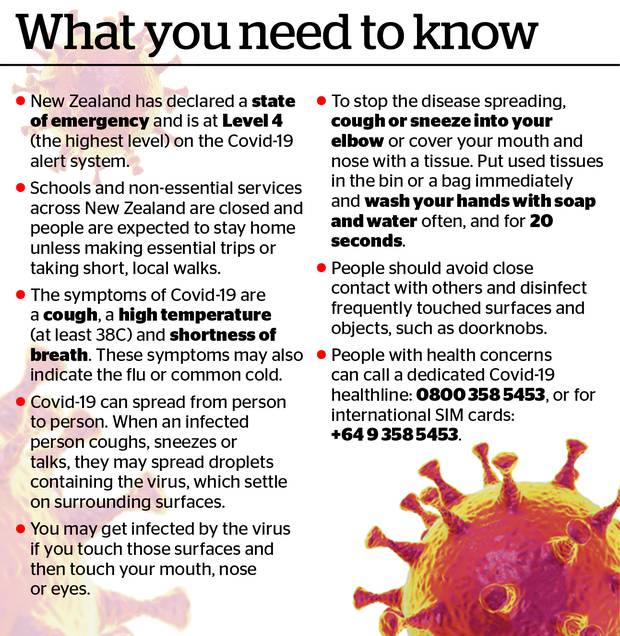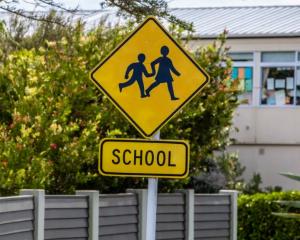New Zealand has 67 new cases of Covid-19 - bringing the total number of cases in New Zealand to 1106.
Director General of Health Ashley Bloomfield is giving today's update on how the lockdown is affecting the spread of Covid-19 in New Zealand.
There are 39 new confirmed cases and 28 probable cases today.
There are 13 people in hospital including three in ICU, one of whom is critical. Two people have been discharged from hospital since yesterday.
There have been no additional deaths and 176 people have recovered.
Two per cent of cases have been confirmed as community transmission. The increase in community transmission showed what they were expecting, Bloomfield said, and was an increase from 10 to 20 of the confirmed cases.
When asked when New Zealand's lockdown alert level could move back to level 3, Bloomfield said they would advise the Government when a number of data points showed it was "quite comfortably" levelling off - but they would like to see the daily number of cases dropping.
"Clearly the levelling off is a good sign. We've clearly avoided that exponential growth."
New Zealand could be encouraged by the levelling off, he said.
The only way to ensure the numbers will drop is to keep doing what we're doing, he said.
New Zealand's numbers are where Bloomfield said he'd hoped they'd be.
Twelve significant clusters
There are still 12 significant clusters - Marist College now has 72 cases.
One of the clusters in Christchurch was at the Rosewood rest home, with 15 confirmed and probable cases.
Twenty of the residents have been moved to be treated at Burwood Hospital to ensure they're appropriately cared for, Bloomfield said.
The local DHB has also put a person inside the rest home to ensure a quality level of care for the 40 people remaining there.
None of the people who'd been moved to hospital were there because of Covid symptoms, he said.
Regarding the Ruby Princess cruise ship, Bloomfield said contact tracing had shown there were two groups of people associated with the cluster of 16.
Two people were passengers on the ship while four people were van drivers, tour guides or translators and one of those people then infected people at a rest home in Hawke's Bay.
Cases by ethnicity
The seven-day rolling average of daily tests is 2846, and just under 40,000 tests have been completed in total. There are 68 testing centres around the country.
New Zealand had a good supply of nasal swabs with another shipment arriving last week, he said.
Auckland, Waikato and Southern have the highest number of cases under investigation.
In terms of ethnicity of the cases, 73.5% are European, 8.4% Asian, 7.8% Maori and 3.4% Pacific, he said.
Bloomfield said 190 staff are now working in contact tracing centres through a national electronic platform.
He said this meant staff could access the National Health Index, which contained a lot of up-to-date information on patients.
Bloomfield said there were looking at mobile phone technology for contact-tracing "at pace".
But the core remained the human call centre, he said.
On surveillance testing, Bloomfield was expecting to release the plan in the next day or two.
On digital contact-tracing, Bloomfield said they weren't "planning to reinvent the wheel" so would use an existing technology but had to be mindful of privacy issues.
On the impact of winter, Bloomfield said there wasn't yet any evidence on seasonality impacting Covid-19.
Quarantine, self-isolation or bubble?
Bloomfield defined "quarantine" as when someone comes in from overseas and are symptomatic. They're taken to a hotel and cared for for the period of their isolation.
"Self-isolation" is someone who is a close contact of a confirmed case, isolated in their own home and isolated from the people in their homes. They can go for a walk but mustn't come into contact with anyone else.
The "bubble" is the situation every other New Zealander is in.
Bloomfield said anyone delaying seeking treatment for other illnesses shouldn't and should still call their GPs to organise an appointment.
"Please do not delay seeking treatment for any medical need you might have," Bloomfield said.
Bloomfield told Newstalk ZB's Mike Hosking this morning that New Zealand had seen an "encouraging" flattening of growth in cases.
He said in the last three or four days - slightly earlier than expected - flattening off had been seen. In the next few days the hope was that there would be a drop in cases.
Officials were looking for that drop this week but it was too early to say whether it would happen.
The Ministry of Health is working with DHBs to make sure that when NZ moves back to alert level 3 or less, important appointments and elective surgery could be carried out.
Hospitals are running at 50-60 per cent capacity - meaning there are about 1000 beds empty. ICU staff are being trained and hospitals getting ready while there are fewer people in hospital.
 Source: NZ Herald
Source: NZ Herald

Comments
Would it not be better to send everyone in NZ 10 face masks and pairs of gloves, and then make it compulsory to wear them, instead of destroying our economy? Social distancing could be relaxed with only the most at risk locked-down. Follow the Korean approach makes more sense. I do not want to contemplate the cost of family dissolutions, suicides and long term unemployment/poverty for NZ whilst our politicians use the variant of the Imperial College model. [PS Prof Ferguson has reduced his UK mortality projections from 500,000 to 10-20,000 last week.] And before someone says 10 is not enough- you can sterilise them after each day's use or by putting them aside for 9 days.













